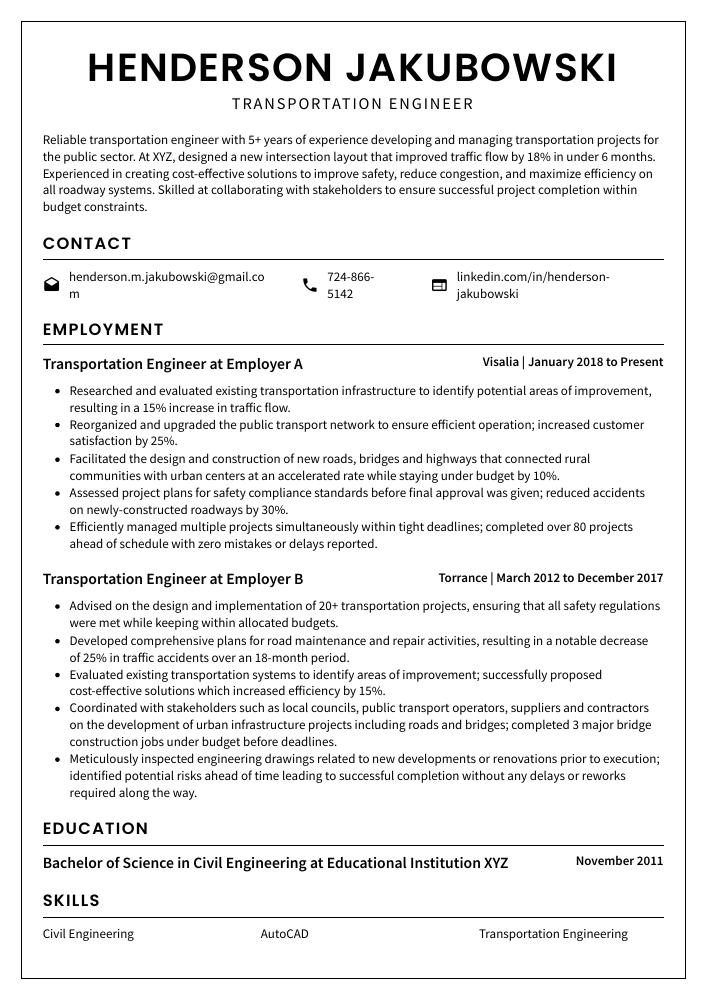Transportation Engineer Resume Guide
Transportation engineers plan, design, and oversee the construction of roads, bridges, airports, railways and other transportation systems. They ensure that these structures are safe to use by conducting tests and inspections on them. Additionally they look for ways to improve existing infrastructure as well as create new solutions in order to meet public needs.
Your knowledge of transportation engineering makes you a great fit for any company. However, potential employers don’t know who you are yet. To make them aware of your expertise and experience, writing an outstanding resume is key.
This guide will walk you through the entire process of creating a top-notch resume. We first show you a complete example and then break down what each resume section should look like.
Table of Contents
The guide is divided into sections for your convenience. You can read it from beginning to end or use the table of contents below to jump to a specific part.
Transportation Engineer Resume Sample
Henderson Jakubowski
Transportation Engineer
[email protected]
724-866-5142
linkedin.com/in/henderson-jakubowski
Summary
Reliable transportation engineer with 5+ years of experience developing and managing transportation projects for the public sector. At XYZ, designed a new intersection layout that improved traffic flow by 18% in under 6 months. Experienced in creating cost-effective solutions to improve safety, reduce congestion, and maximize efficiency on all roadway systems. Skilled at collaborating with stakeholders to ensure successful project completion within budget constraints.
Experience
Transportation Engineer, Employer A
Visalia, Jan 2018 – Present
- Researched and evaluated existing transportation infrastructure to identify potential areas of improvement, resulting in a 15% increase in traffic flow.
- Reorganized and upgraded the public transport network to ensure efficient operation; increased customer satisfaction by 25%.
- Facilitated the design and construction of new roads, bridges and highways that connected rural communities with urban centers at an accelerated rate while staying under budget by 10%.
- Assessed project plans for safety compliance standards before final approval was given; reduced accidents on newly-constructed roadways by 30%.
- Efficiently managed multiple projects simultaneously within tight deadlines; completed over 80 projects ahead of schedule with zero mistakes or delays reported.
Transportation Engineer, Employer B
Torrance, Mar 2012 – Dec 2017
- Advised on the design and implementation of 20+ transportation projects, ensuring that all safety regulations were met while keeping within allocated budgets.
- Developed comprehensive plans for road maintenance and repair activities, resulting in a notable decrease of 25% in traffic accidents over an 18-month period.
- Evaluated existing transportation systems to identify areas of improvement; successfully proposed cost-effective solutions which increased efficiency by 15%.
- Coordinated with stakeholders such as local councils, public transport operators, suppliers and contractors on the development of urban infrastructure projects including roads and bridges; completed 3 major bridge construction jobs under budget before deadlines.
- Meticulously inspected engineering drawings related to new developments or renovations prior to execution; identified potential risks ahead of time leading to successful completion without any delays or reworks required along the way.
Skills
- Civil Engineering
- AutoCAD
- Transportation Engineering
- MicroStation
- Highways
- Engineering
- Traffic Engineering
- Road
- Transportation Planning
Education
Bachelor of Science in Civil Engineering
Educational Institution XYZ
Nov 2011
Certifications
Professional Traffic Operations Engineer (PTOE)
Institute of Transportation
May 2017
1. Summary / Objective
The summary/objective at the top of your resume is like a trailer – it provides the employer with an overview of who you are and why you excel as a transportation engineer. This section should emphasize your best qualities, such as experience in designing roads, bridges, tunnels and other infrastructure; knowledge of relevant software programs; certifications or licenses related to engineering; and any awards or recognition for outstanding work.
Below are some resume summary examples:
Enthusiastic and goal-oriented transportation engineer with 5+ years of experience designing, developing, testing, and implementing innovative solutions to improve the efficiency of public transport networks. At ABC Corporation I developed a computerized system for tracking buses which improved fleet utilization by 20%. Looking forward to applying my expertise in data analysis and engineering principles at XYZ Company to help drive positive change in transit systems.
Hard-working transportation engineer with 5+ years of experience in project management and design. At XYZ, designed a 6-mile bridge connecting two cities, which was completed ahead of schedule and under budget. Experienced in the planning and implementation of various highway construction projects for local governments. Skilled at using AutoCAD to create detailed drawings for civil engineering projects; knowledgeable about relevant building codes and regulations.
Skilled transportation engineer with over 10 years of experience in the planning and design of roadway projects. Proven track record of success managing complex transportation infrastructure projects on time and budget. Experienced in the application of engineering principles, techniques, practices and standards to ensure safety, reliability, quality assurance/quality control (QA/QC), cost-effectiveness, project schedules met or exceeded within budget guidelines.
Energetic and detail-oriented civil engineer with 5+ years of experience in transportation engineering. Specialize in designing and executing safe, efficient roadways for high traffic areas while keeping environmental concerns top-of-mind. Experienced in utilizing AutoCAD Civil 3D to create detailed plans and renderings that adhere to local regulations. Seeking a role at ABC Tech where I can use my skillset to help modernize the city’s infrastructure.
Accomplished transportation engineer with 4+ years of experience in the design, implementation, and maintenance of transportation infrastructure. Proven track record of successfully completing complex projects on-time and under budget. Skilled at creating plans that optimize traffic flow while minimizing environmental impact. Seeking to join ABC Engineering as a Transportation Engineer to deliver innovative solutions for their clients’ needs.
Proficient Transportation Engineer with 8+ years of experience in the planning and design of transportation infrastructure systems. Seeking to bring my expertise in traffic engineering, road construction management, and GIS mapping to ABC Tech’s multidisciplinary team. At XYZ Engineering Firm, successfully completed a major roadway project on budget and ahead of schedule—a feat that earned me an award for excellence from the state government.
Diligent and resourceful transportation engineer with 5+ years of experience in planning, designing, and managing construction projects related to the transport industry. Skilled at analyzing data from surveys, reports, studies and GIS mapping systems to create cost-effective solutions that meet safety requirements while minimizing environmental impact. Excels at collaborating with stakeholders to ensure project success.
Dependable transportation engineer with 7+ years of experience developing efficient transportation systems. Skilled in designing and constructing roads, bridges, tunnels, and other infrastructure projects while adhering to safety standards. Seeking an opportunity at ABC to utilize my knowledge of civil engineering principles to develop innovative solutions for the organization’s transport challenges.
2. Experience / Employment
For the experience section, you want to list your employment history in reverse chronological order. This means that the most recent job is listed first.
When writing out what you did, stick to bullet points primarily; this makes it easier for the reader to digest what you have written quickly and efficiently. You should also take some time to think about providing detail on what exactly you did and any quantifiable results obtained from your efforts.
For example, instead of saying “Designed transportation networks,” try something like “Developed a new transportation network model for an urban area which resulted in a 15% reduction of traffic congestion.”
To write effective bullet points, begin with a strong verb or adverb. Industry specific verbs to use are:
- Designed
- Constructed
- Inspected
- Operated
- Monitored
- Evaluated
- Analyzed
- Researched
- Coordinated
- Scheduled
- Implemented
- Improved
- Developed
- Supervised
- Assessed
Other general verbs you can use are:
- Achieved
- Advised
- Compiled
- Demonstrated
- Expedited
- Facilitated
- Formulated
- Introduced
- Mentored
- Optimized
- Participated
- Prepared
- Presented
- Reduced
- Reorganized
- Represented
- Revised
- Spearheaded
- Streamlined
- Structured
- Utilized
Below are some example bullet points:
- Mentored and trained a team of 10 junior engineers in the design, construction and operation of transportation infrastructure projects; increased overall efficiency by 33%.
- Revised traffic flow regulations for commercial vehicles, resulting in improved safety on highways across the state and a reduction in accident rates by 15%.
- Supervised teams responsible for maintenance work on up to 50 roads simultaneously within budget restraints; completed all necessary repairs ahead of schedule with savings totaling $20K.
- Compiled detailed reports outlining existing roadway layouts and upcoming improvements based upon field surveys; identified potential issues that could arise during construction stages before they occurred.
- Confidently managed complex engineering tasks related to bridge building, tunneling operations and asphalt pavement installation while completing each project within allocated deadlines set forth by clients or government agencies.
- Analyzed traffic flow patterns of local roads and highways to identify potential congestion points; reduced travel time by an average of 25% through the implementation of a new traffic light system.
- Reduced operational costs for public transportation projects by 14%, ensuring that all safety standards were met while optimizing budget allocations.
- Presented innovative solutions for existing transportation infrastructure challenges before stakeholders, receiving positive feedback from various county boards & committees on multiple occasions.
- Independently designed 6+ roadways using AutoCAD software, efficiently meeting project deadlines within allotted budgets and specifications each time.
- Scheduled daily inspections as part of regular maintenance protocols to ensure proper functioning and upkeep of vehicles in fleet; conducted monthly check-ups on over 100 buses with minimal downtime reported every month.
- Monitored the construction of 2 highway transportation projects, ensuring that the design plans were strictly adhered to and that they met all safety regulations.
- Formulated comprehensive budget plans for 4 bridge designs; successfully reduced overall costs by 16% while maintaining quality standards.
- Reliably managed a team of 10+ engineers on various research initiatives, resulting in 5 successful proposals for public transit improvements being submitted to government authorities within 6 months.
- Constructed 3 new interchanges from scratch using advanced engineering techniques and cutting-edge materials; completed work ahead of schedule without exceeding allocated funds by more than 1%.
- Structured an effective traffic management system covering 25 miles of roads which increased vehicular flow capacity by 14%, significantly decreasing commute times during peak hours in the area.
- Optimized transportation networks for increased safety and efficiency, resulting in a 15% reduction in the number of traffic accidents.
- Utilized AutoCAD software to design roadways that meet local regulations and requirements; decreased construction time with more accurate designs.
- Diligently monitored transportation systems operations, ensuring compliance with all governmental standards and regulations; improved public satisfaction by 10%.
- Operated surveying equipment such as total stations & GPS receivers onsite to determine elevations/locations for proposed infrastructures; reduced costs by $20,000 annually due to accuracy of measurements taken during surveys.
- Inspected existing infrastructure components (bridges, roads etc.) regularly to identify areas needing repair or replacement works before potential damages occur; saved an additional $15,000 each year from preventive maintenance actions taken after inspections were completed successfully.
- Achieved a 20% reduction in traffic congestion through successful implementation of smart transportation systems.
- Spearheaded the development and testing of new technologies that improved safety on roadways by 25%.
- Actively monitored, maintained and updated existing transport infrastructure to ensure compliance with government regulations; decreased maintenance costs by $10,000 annually.
- Demonstrated strong engineering expertise when designing efficient high-speed rail networks for urban areas; reduced travel time between cities by 3 hours on average.
- Implemented advanced traffic monitoring systems to detect potential hazards early and reduce accidents caused due to human error or negligence by 45%.
- Streamlined the transportation process by developing a new route network which decreased travel time by 20% and increased efficiency of deliveries.
- Expedited the implementation of traffic control systems, resulting in improved vehicle flow through intersections and reduced congestion on local roads; saved $10K in traffic management costs annually.
- Accurately designed road layouts using CAD software to ensure they meet safety standards while minimizing disruption to existing infrastructure; achieved 95% accuracy rate for all projects completed over last 12 months.
- Prepared detailed design plans, technical reports and cost estimates for proposed transport solutions according to customer needs; created 10+ project proposals with an average success rate of 90%.
- Developed innovative strategies for reducing air pollution from vehicles traveling along highways/motorways that led to a reduction in CO2 emissions by 25%.
- Resourcefully designed and implemented transportation plans that improved the flow of traffic in urban areas by 15%.
- Represented a team of engineers at local government meetings to discuss new initiatives, garner stakeholder support, and explain the value-adds of proposed projects.
- Introduced innovative safety measures such as enhanced lighting systems on highways which reduced road accidents by 20% over six months.
- Participated in various research activities related to public transit development including field surveys for route optimization; generated actionable insights from data analysis which resulted in 8 successful project proposals being approved within one year’s time frame.
- Improved vehicle turn-around times at cargo ports with automated loading/unloading processes resulting in an operational cost reduction of $25,000 annually.
3. Skills
Skill requirements will differ from employer to employer – this can easily be determined via the job advert. Organization ABC may be looking for a transportation engineer who is well-versed in traffic engineering and Organization XYZ may need someone with experience in public transit planning.
It’s important to tailor the skills section of your resume to each job you are applying for because many employers use applicant tracking systems these days, which scan resumes for certain keywords before passing them on to a human.
In addition, it would also be beneficial to elaborate on some of the most relevant skills throughout other sections such as summary or work experience.
Below is a list of common skills & terms:
- ArcGIS
- AutoCAD
- AutoCAD Civil 3D
- Bentley MicroStation
- Bridge
- CAD
- Civil Engineering
- Concrete
- Construction Management
- Contract Management
- Data Analysis
- Drainage
- Engineering
- Erosion Control
- GEOPAK
- GIS
- Geotechnical Engineering
- Highway Design
- Highways
- Hydrology
- Inroads
- Land Development
- MATLAB
- MicroStation
- Project Estimation
- Project Planning
- Road
- Road Traffic
- Stormwater Management
- Structural Analysis
- Structural Engineering
- Surveying
- Synchro
- TRAFFIC SIGNAL DESIGN
- Teamwork
- Time Management
- Traffic Analysis
- Traffic Engineering
- Transportation
- Transportation Engineering
- Transportation Planning
4. Education
Mentioning an education section on your resume will depend on how far along you are in your career. If you just graduated and have no prior experience, include the details of your educational background below your objective statement. However, if you have a substantial amount of work experience to showcase, it might be best not to include this section altogether.
If including an education section is necessary for the job application, try mentioning courses and subjects related to transportation engineering that are relevant to the position being applied for.
Bachelor of Science in Civil Engineering
Educational Institution XYZ
Nov 2011
5. Certifications
Certifications are a great way to demonstrate your knowledge and expertise in a particular field. They also show potential employers that you are committed to professional development and keeping up with the latest industry trends.
Including certifications on your resume is an effective way of showing hiring managers that you have what it takes for the job, so make sure to include any relevant ones when applying for positions.
Professional Traffic Operations Engineer (PTOE)
Institute of Transportation
May 2017
6. Contact Info
Your name should be the first thing a reader sees when viewing your resume, so ensure its positioning is prominent. Your phone number should be written in the most commonly used format in your country/city/state, and your email address should be professional.
You can also choose to include a link to your LinkedIn profile, personal website, or other online platforms relevant to your industry.
Finally, name your resume file appropriately to help hiring managers; for Henderson Jakubowski, this would be Henderson-Jakubowski-resume.pdf or Henderson-Jakubowski-resume.docx.
7. Cover Letter
Writing a cover letter is an important part of the job application process. It gives you a chance to showcase your personality, explain why you’re interested in the role and demonstrate how qualified you are for it.
Cover letters should be concise and include 2 to 4 paragraphs that provide more detail on what makes you suitable for the position. They can also be used as a way to introduce yourself if there is no other opportunity during the hiring process.
Below is an example cover letter:
Dear Wilber,
As a civil engineer with 7+ years of experience working on transportation infrastructure projects, I am confident in my ability to contribute to the success of your organization. My hands-on experience managing all aspects of transportation engineering projects, from initial planning through final construction, has given me a well-rounded skillset that can be applied to many different types of projects.
In my current role as Senior Transportation Engineer at [company name], I am responsible for leading a team of engineers and technicians in the design and construction of highways, bridges, and other transportation infrastructure. I have successfully managed projects totaling more than $100 million in value, including the recent reconstruction of the [highway name] highway interchange. My project management experience has taught me how to effectively communicate with all stakeholders involved in a project, from government agencies and contractors to private landowners.
I am knowledgeable about all relevant federal regulations governing transportation engineering projects and have successfully navigated the permitting process for several large-scale projects. In addition, I have developed strong relationships with local officials and agency representatives that will benefit any future projects undertaken by your organization.
I welcome the opportunity to discuss how my skills and experience can be put to use benefiting your organization. Please find attached a copy of my resume for your review; I can be reached anytime via phone or email. Thank you for your time and consideration!
Sincerely,
Henderson
Transportation Engineer Resume Templates
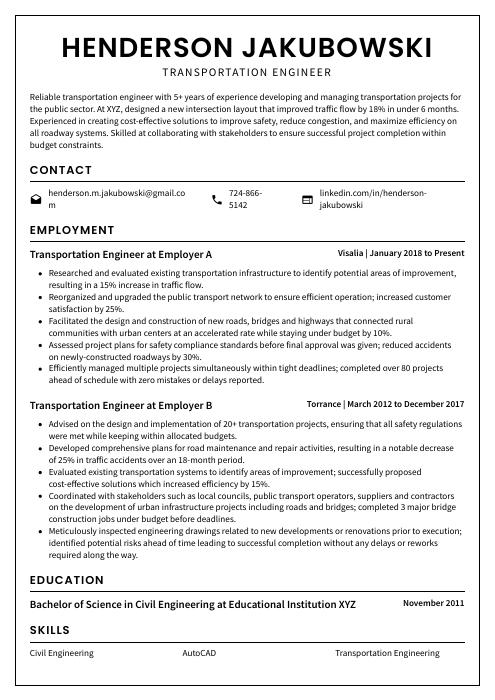 Cormorant
Cormorant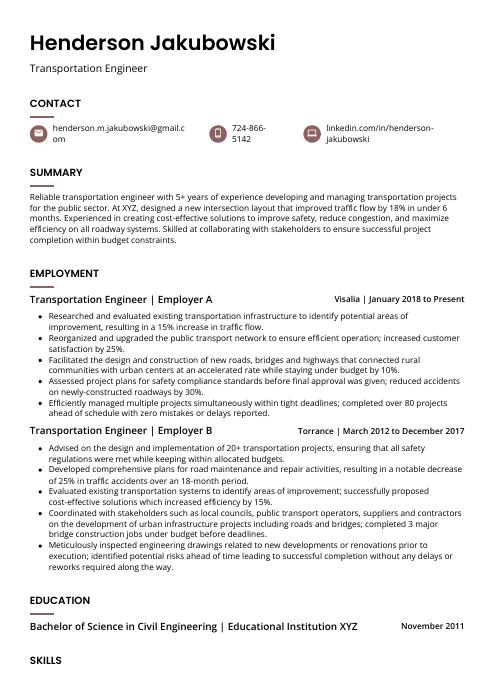 Fossa
Fossa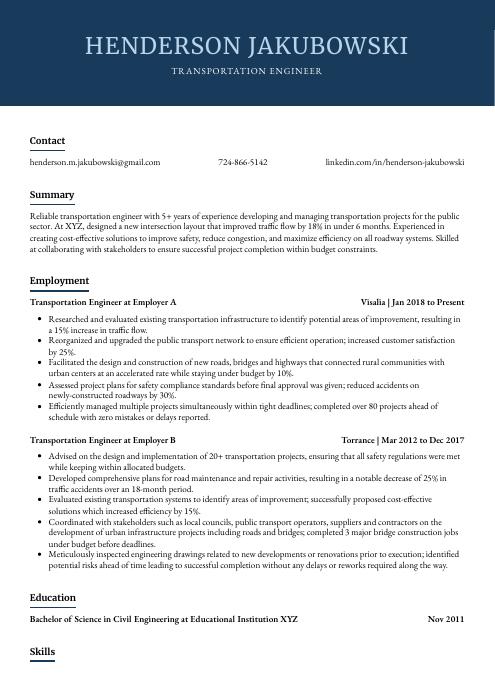 Bonobo
Bonobo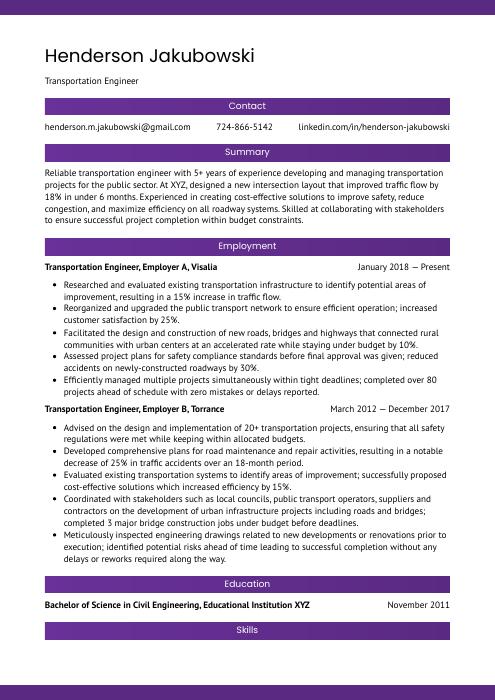 Jerboa
Jerboa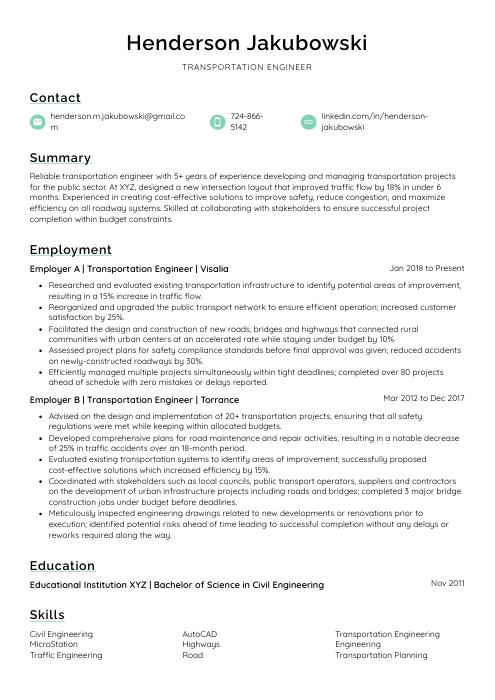 Lorikeet
Lorikeet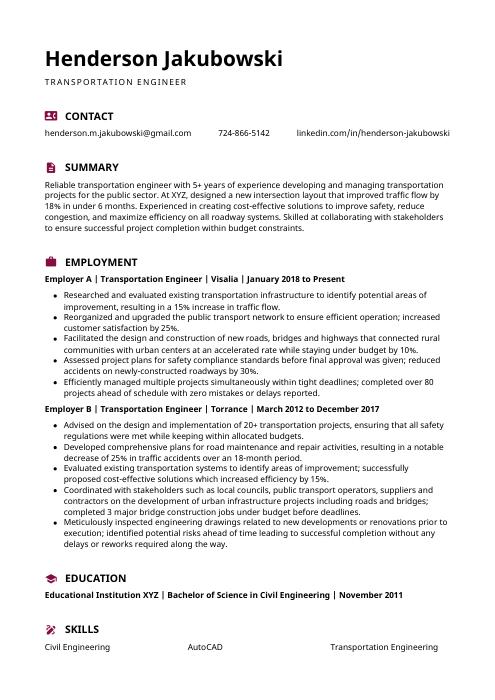 Hoopoe
Hoopoe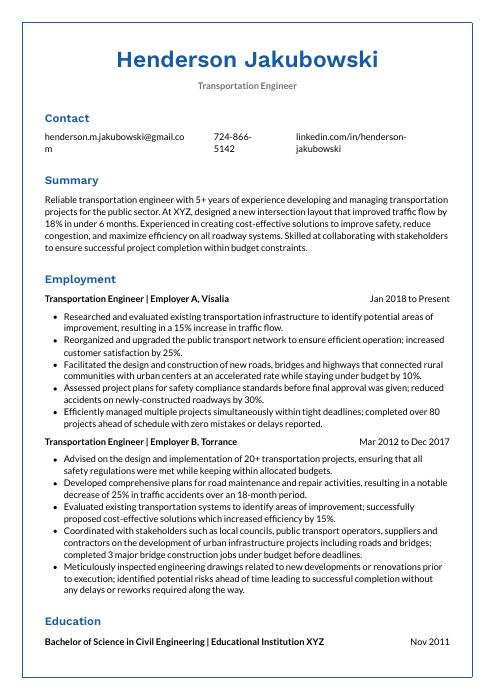 Markhor
Markhor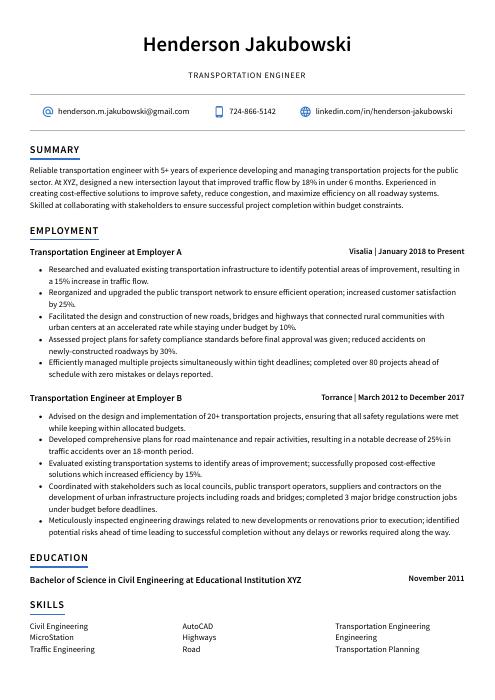 Axolotl
Axolotl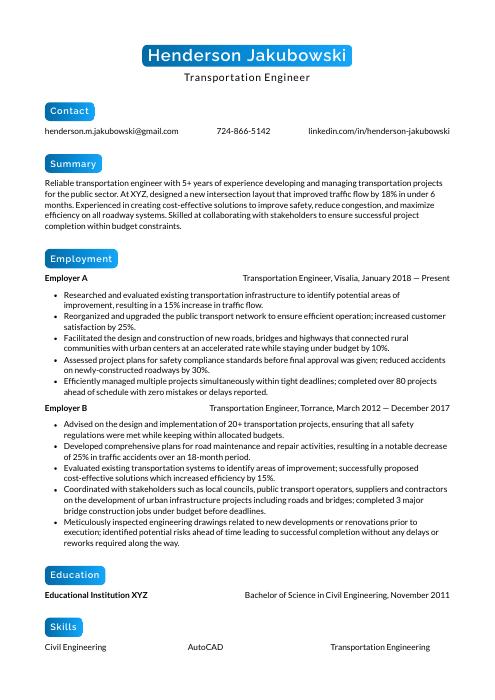 Kinkajou
Kinkajou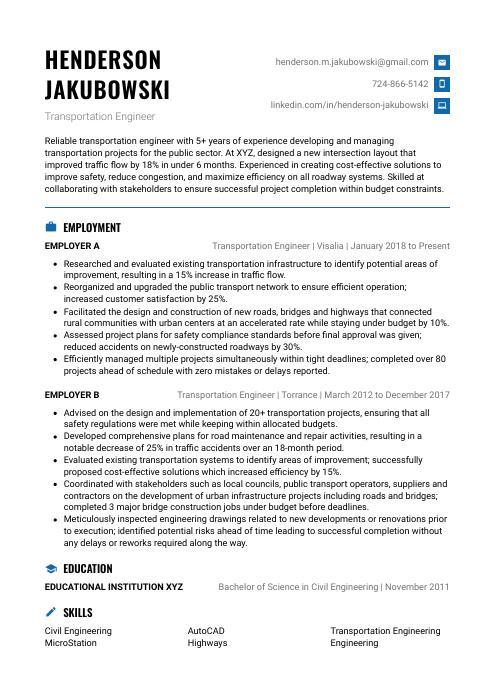 Echidna
Echidna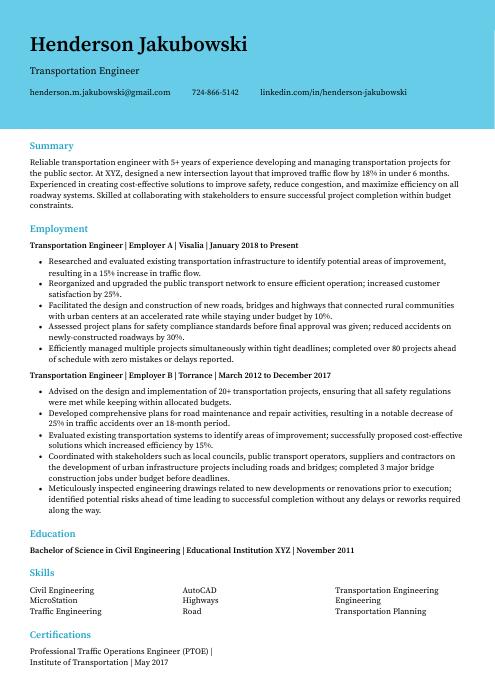 Dugong
Dugong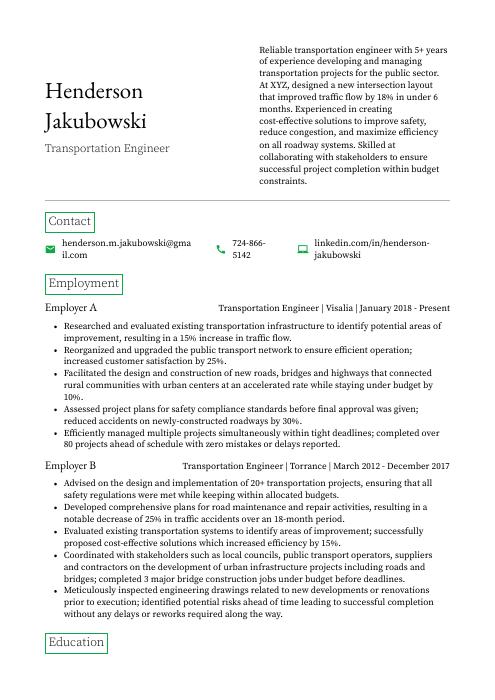 Quokka
Quokka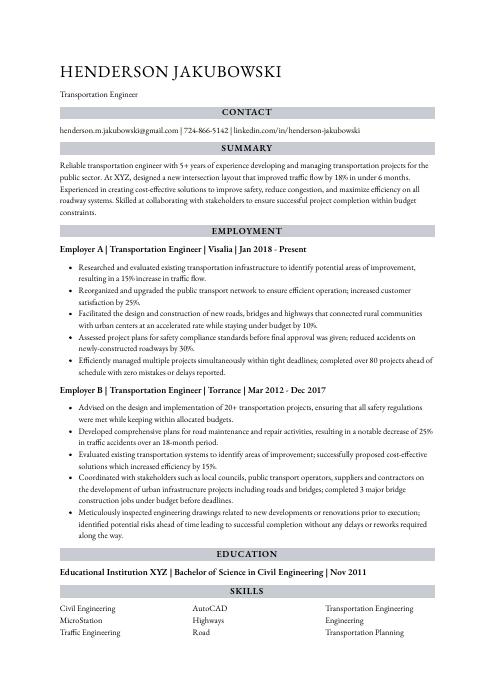 Numbat
Numbat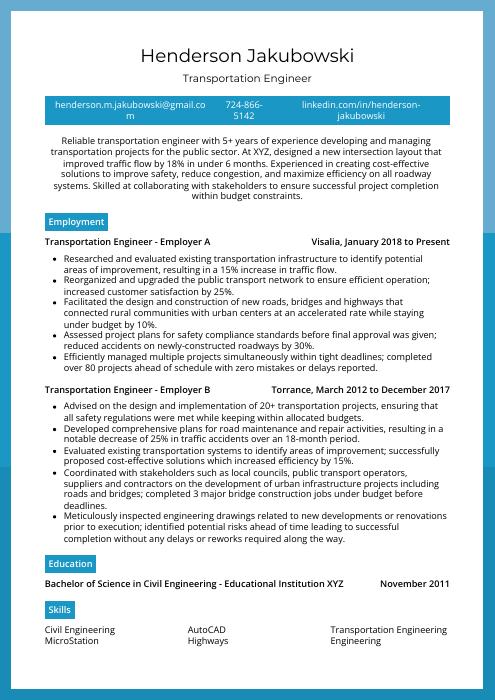 Rhea
Rhea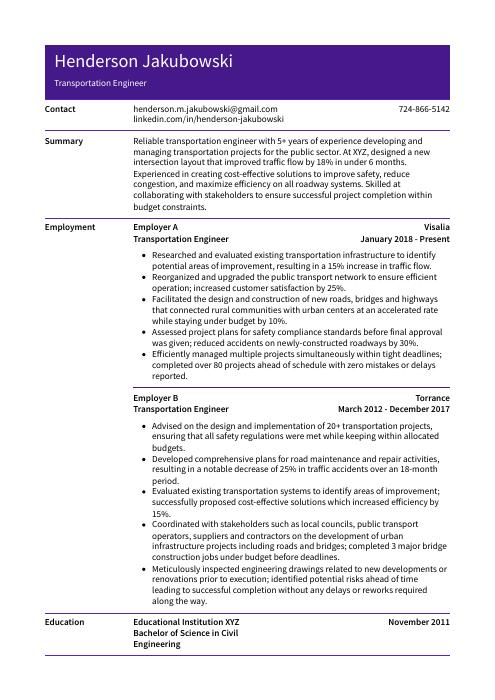 Pika
Pika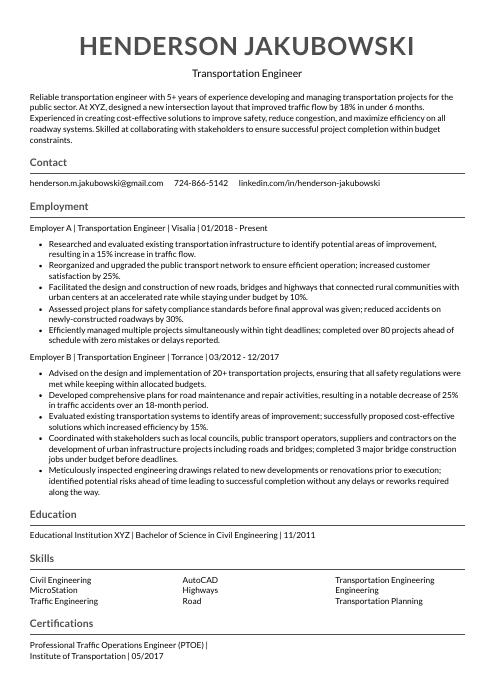 Indri
Indri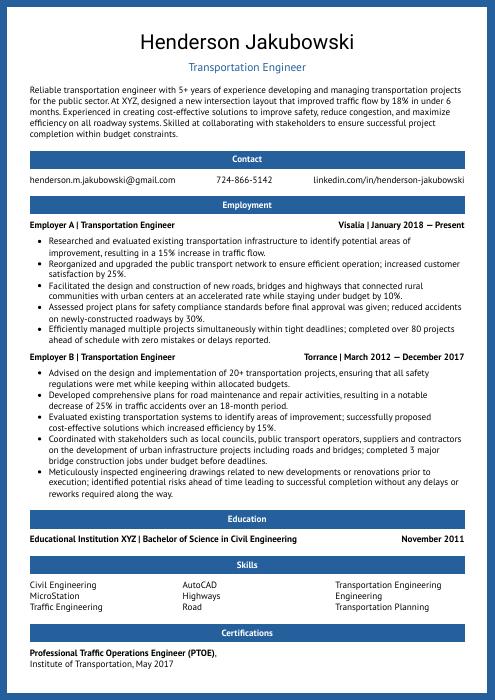 Ocelot
Ocelot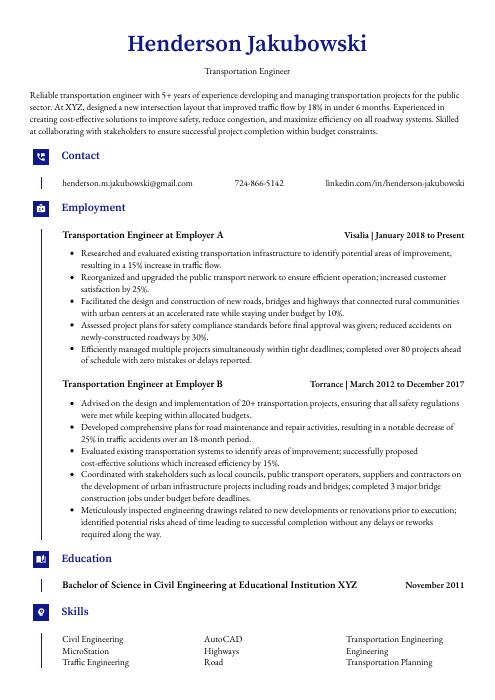 Gharial
Gharial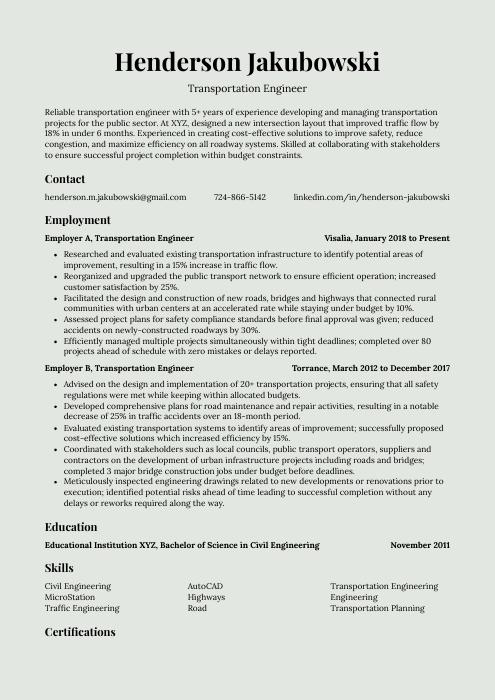 Saola
Saola Rezjumei
Rezjumei
